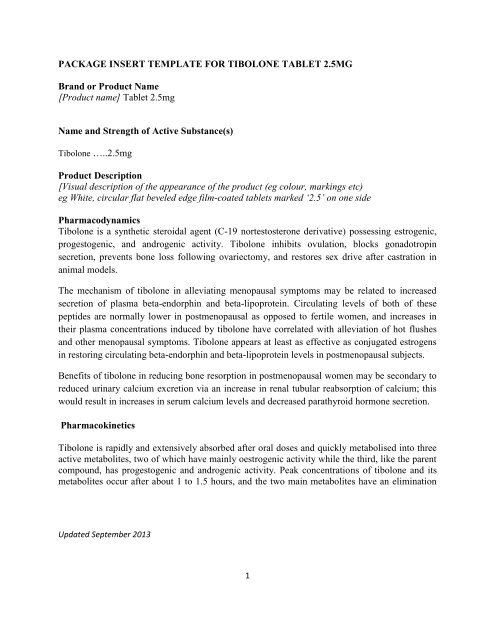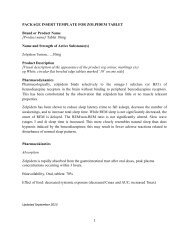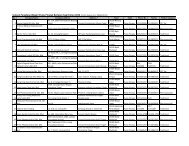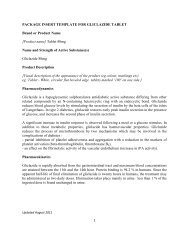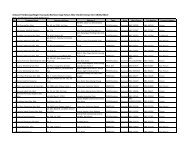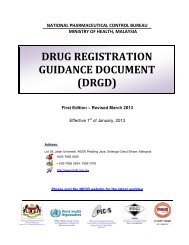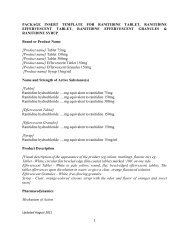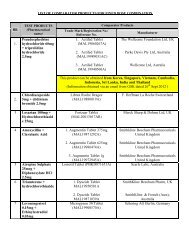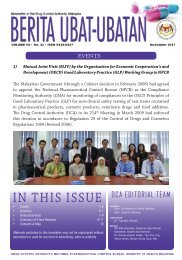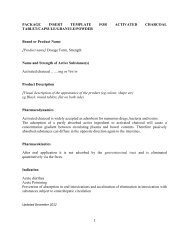248 KB - BPFK
248 KB - BPFK
248 KB - BPFK
You also want an ePaper? Increase the reach of your titles
YUMPU automatically turns print PDFs into web optimized ePapers that Google loves.
PACKAGE INSERT TEMPLATE FOR TIBOLONE TABLET 2.5MGBrand or Product Name[Product name] Tablet 2.5mgName and Strength of Active Substance(s)Tibolone …..2.5mgProduct Description[Visual description of the appearance of the product (eg colour, markings etc)eg White, circular flat beveled edge film-coated tablets marked ‘2.5’ on one sidePharmacodynamicsTibolone is a synthetic steroidal agent (C-19 nortestosterone derivative) possessing estrogenic,progestogenic, and androgenic activity. Tibolone inhibits ovulation, blocks gonadotropinsecretion, prevents bone loss following ovariectomy, and restores sex drive after castration inanimal models.The mechanism of tibolone in alleviating menopausal symptoms may be related to increasedsecretion of plasma beta-endorphin and beta-lipoprotein. Circulating levels of both of thesepeptides are normally lower in postmenopausal as opposed to fertile women, and increases intheir plasma concentrations induced by tibolone have correlated with alleviation of hot flushesand other menopausal symptoms. Tibolone appears at least as effective as conjugated estrogensin restoring circulating beta-endorphin and beta-lipoprotein levels in postmenopausal subjects.Benefits of tibolone in reducing bone resorption in postmenopausal women may be secondary toreduced urinary calcium excretion via an increase in renal tubular reabsorption of calcium; thiswould result in increases in serum calcium levels and decreased parathyroid hormone secretion.PharmacokineticsTibolone is rapidly and extensively absorbed after oral doses and quickly metabolised into threeactive metabolites, two of which have mainly oestrogenic activity while the third, like the parentcompound, has progestogenic and androgenic activity. Peak concentrations of tibolone and itsmetabolites occur after about 1 to 1.5 hours, and the two main metabolites have an eliminationUpdated September 20131
half-life of about 7 hours. Metabolites are excreted in the bile and eliminated in the faeces. About30% of a dose is excreted in the urine.The consumption of food had no significant effects on the extent of absorption.The pharmacokinetic parameters for tibolone and its metabolites were found to be independentof renal function.Indication• Treatment of complaints resulting from the natural or artificial menopause. Women above 60years of age should only start with tibolone treatment when they are intolerant of, orcontraindicated for, other medicinal products approved for the treatment of estrogen deficiencysymptoms.• Prevention of osteoporosis in postmenopausal women at high risk of future fractures who areintolerant of, or contraindicated for, other medicinal products approved for the prevention ofosteoporosis.Recommended DosageThe dosage is one tablet per day. No dose adjustment is necessary for the elderly. The tabletsshould be swallowed with some water or other drink, preferably at the same time every day.For initiation and continuation of treatment of postmenopausal symptoms, the lowest effectivedose for the shortest duration should be used.A separate progestogen should not be added with tibolone treatment.Starting tiboloneWomen experiencing a natural menopause should commence treatment with tibolone at least 12months after their last natural bleed. In case of a surgical menopause, treatment with tibolonemay commence immediately.Any irregular/unscheduled vaginal bleeding, either on or off HRT, should be investigated toexclude malignancy before starting tibolone.Switching from a sequential or continuous combined HRT preparationIf changing from a sequential HRT preparation, treatment with tibolone should start the dayfollowing completion of the prior regimen. If changing from a continuous-combined HRTpreparation, treatment can start at any time.Missed doseA missed dose should be taken as soon as remembered, unless it is more than 12 hours overdue.Updated September 20132
In the latter case, the missed dose should be skipped and the next dose should be taken at thenormal time. Missing a dose may increase the likelihood of breakthrough bleeding and spotting.Mode of AdministrationOralContraindications• Known, past or suspected breast cancer• Pregnancy and lactation• Known or suspected estrogen-dependent malignant tumors (e.g.endometrial cancer)• Undiagnosed genital bleeding• Untreated endometrial hyperplasia• Previous or current venous thromboembolism (deep venous thrombosis, pulmonary embolism)• Known thrombophilic disorders (e.g. protein C, protein S, or antithrombin deficiency)• Any history of arterial thromboembolic disease (e.g. angina, myocardial infarction, stroke orTIA)• Acute liver disease or a history of liver disease as long as liver function tests have failed toreturn to normal• Known hypersensitivity to the active substance or to any of the excipients• PorphyriaWarnings and PrecautionsTibolone is not intended for contraceptive use.For the treatment of postmenopausal symptoms, tibolone should only be initiated for symptomsthat adversely affect quality of life. In all cases, a careful appraisal of the risks and benefitsshould be undertaken at least annually and tibolone should only be continued as long as thebenefit outweighs the risk.The risks of stroke, breast cancer and, in women with an intact uterus, endometrial cancer foreach woman should be carefully assessed, in the light of her individual risk factors and bearingin mind the frequency and characteristics of both cancers and stroke, in terms of their response totreatment, morbidity and mortality.Evidence regarding the risks associated with HRT or tibolone in the treatment of prematuremenopause is limited. Due to the low level of absolute risk in younger women, however, thebalance of benefits and risks for these women may be more favourable than in older women.Updated September 20133
Use of tibolone within 12 months of a natural menopause is not recommended because irregularvaginal bleeding is likely. Breakthrough bleeding and spotting may occur in the first few monthsof therapy, but should be investigated if it persists beyond 6 months, starts after that time, orcontinues after tibolone has been stopped. Missing a dose may increase the likelihood ofbleeding and spotting.Medical examination/follow-upBefore initiating or reinstituting HRT or tibolone, a complete personal and family medicalhistory should be taken. Physical (including pelvic and breast) examination should be guided bythis and by the contraindications and warnings for use. During treatment, periodic check-ups arerecommended of a frequency and nature adapted to the individual woman. Women should beadvised what changes in their breasts should be reported to their doctor or nurse. Investigations,including appropriate imaging tools, e.g. mammography, should be carried out in accordancewith currently accepted screening practices, modified to the clinical needs of the individual.Conditions which need supervisionIf any of the following conditions are present, have occurred previously, and/or have beenaggravated during pregnancy or previous hormone treatment, the patient should be closelysupervised. It should be taken into account that these conditions may recur or be aggravatedduring treatment with tibolone, in particular:- Leiomyoma (uterine fibroids) or endometriosis- Risk factors for thromboembolic disorders- Risk factors for estrogen dependent tumors, e.g. 1 st degree heredity for breast cancer- Hypertension- Liver disorders (e.g. liver adenoma)- Diabetes mellitus with or without vascular involvement- Cholelithiasis- Migraine or (severe) headache- Systemic lupus erythematosisUpdated September 20134
- A history of endometrial hyperplasia- Epilepsy- Asthma- Otosclerosis- Dyslipidaemia- Disorders that may be exacerbated by fluid retention such as cardiac or renal dysfunctionReasons for immediate withdrawal of therapy:Therapy should be discontinued in case a contraindication is discovered and in the followingsituations:Jaundice or deterioration in liver functionSignificant increase in blood pressureNew onset of migraine-type headacheSigns of thromboembolism*Consideration should be given to stopping tibolone 4 to 6 weeks before elective surgery whenprolonged immobilisation after surgery is likely.Effects on the ability to drive and use machinesTibolone is not known to have any effects on alertness and concentration.Interactions with Other MedicamentsThere is limited information regarding pharmacokinetic interactions with tibolone. An in vivostudy showed that simultaneous treatment of tibolone affects pharmacokinetics of thecytochrome P450 3A4 substrate midazolam to a moderate extent. Based on this, druginteractions with other CYP3A4 substrates might be expected.Compounds that induce liver enzymes, such as phenytoin, carbamazepine, and rifampicin, mighttheoretically enhance the metabolism of tibolone and thus reduce its activity.Updated September 20135
the genital tract may include leucorrhoea, pruritus, candidiasis, and vaginitis. Other adverseeffects have included breast pain, weight gain, oedema, dizziness, skin reactions, headache,migraine, visual disturbances, gastrointestinal disturbances, hypertrichosis, altered liver function,depression, and arthralgia or myalgia.Other adverse reactions have been reported in association with estrogen and estrogenprogestogentreatment:- Long term use of estrogen-only and combined estrogen-progestagen HRT has beenassociated with a slightly increased risk of ovarian cancer.- HRT is associated with a 1.3-3-fold increased relative risk of developing venousthromboembolism (VTE), i.e. deep vein thrombosis or pulmonary embolism. Theoccurrence of such an event is more likely in the first year of using HRT- The risk of coronary artery disease is slightly increased in users of combinedestrogen-progestagen HRT over the age of 60. There is no evidence to suggest thatthe risk of myocardial infarction with tibolone is different to the risk with other HRT.- Gall bladder disease- Skin and subcutaneous disorders: chloasma, erythema multiforme, erythemanodosum, vascular purpura- Probable dementia over the age of 65Breast cancer riskAn up to 2-fold increased risk of having breast cancer diagnosed is reported in womentaking combined estrogen-progestagen therapy for more than 5 years.Any increased risk in users of estrogen-only and tibolone therapy is substantially lowerthan that seen in users of estrogen-progestagen combinations.The level of risk is dependent on the duration of useEndometrial cancer riskUpdated September 20137


